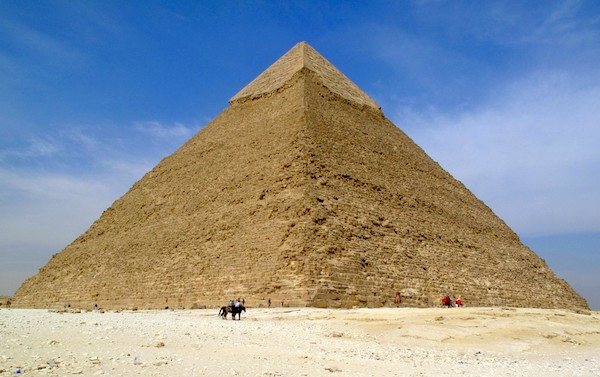Great Pyramid of Giza not square - The Great Pyramid of Giza has fascinated people for thousands of years with its ancient construction and debate on how the ancient monument was built. At 4500 years old, it is part of the seven wonders of the world and stands 449 feet in height and is the largest pyramid ever built by man. But now researchers have a few secrets to unveil about the pyramid, a small flaw after measuring its construction. A flaw at the base of the pyramid that would show it’s not a perfect square as once documented.
Researchers say the west side of the pyramid is slightly longer than the east side, scientists have found. Although the difference is very slight, it’s enough that a modern-day research team, led by engineer Glen Dash and Egyptologist Mark Lehner, was able to detect the small flaw in a new measuring project.
“The base is not quite square,” Dash said. The project is being carried out by the Glen Dash Research Foundation, led by Dash, and Ancient Egypt Research Associates (AERA), led by Lehner. AERA has been mapping and excavating the Giza plateau for about 30 years.
The Great Pyramid was built for the pharaoh Khufu about 4,500 years ago. Called a “wonder of the world” by ancient writers, it is the largest of the three pyramids located on the Giza Plateau.
When the Great Pyramid was first constructed, it was clad in a limestone casing, much of which is now gone. Much of the casing was reused for building projects in past centuries. Without the casing, scientists have had a tough time getting accurate measurements of the pyramid as it originally stood.
“What is the exact size and orientation of the Great Pyramid? Archaeologists, scientists, engineers and mystics have sought answers for centuries,” Dash wrote in a reportpublished in the most recent issue of the newsletter Aeragram, which chronicles the work of AERA.
“Most of those casing stones were removed centuries ago for building material, leaving the pyramid as we see it today, without most of its original shell,” Dash wrote.
To determine the lengths of the original pyramid sides, Lehner led a search for surviving casing stones whose edges still touched the platformthat the Great Pyramid was built on. They also searched for marks on the platform that would provide clues as to where the edges were. In total, they found 84 points along the pyramid’s original edges. These points were marked on a grid system that AERA has been using to map all of the features on the Giza Plateau.
Then, the team used a statistical method called linear regression analysis to determine those lengths. They found that the east side of the pyramid originally measured somewhere between 755.561 and 755.817 feet, while the west side of the pyramid originally measured somewhere between 755.833 and 756.024 feet.
This means that, at most, the west side was only 5.55 inches longer than the east side. Though that would leave the pyramid not quite square, it’s a remarkable level of precision for a monument constructed more than 4,500 years ago, the researchers noted.
“The data show that the Egyptians possessed quite remarkable skills for their time,” Dash wrote in the report. “We can only speculate as to how the Egyptians could have laid out these lines with such precision using only the tools they had.” [How Were the Egyptian Pyramids Built?]
Dash thinks the ancient Egyptians laid out the pyramid on a grid. The pyramid’s north-south axis (or meridian) runs 3 minutes 54 seconds west of due north while its east-west axis runs 3 minutes 51 seconds north of due east, he told Live Science. The east-west axis also runs through the center of a temple built on the east side of the pyramid. These measurements mean that the Great Pyramid is oriented just slightly away from the cardinal directions, the degree of error from north-south and east-west being almost the same.
The fact that the degree of error is almost the same and that it is so small provides “good evidence that the pyramid and its associated temple were laid out on a common, very precisely oriented grid,” Dash said.
The researchers will continue analyzing the data they gathered to find more information on the design and construction of the Great Pyramid.











